When the American Revolution began, some military planners turned their eyes northward toward the province of Quebec. The rationale was that the formerly French province then in British hands would welcome the Americans and support them in their revolt. The idea of a fourteenth colony rebelling against British rule was appealing. Ethan Allen’s seizure of Fort Ticonderoga opened a river highway into the heart of Quebec. American generals lobbied Congress to authorize an invasion which would gain an ally, threaten the position of the Indians in New England and New York, and secure America’s northern boundaries.

Congress was persuaded, and gradually a two-pronged attack on Quebec was planned. On the maps, it looked to be simple. One army was to advance from Ticonderoga, capture Montreal, and then drive on the citadel of Quebec. It would be joined by another, which would move by boat up the Kennebec River through the Maine wilderness. The Continental Congress invited leading French-Canadians to join in the attack, and when no reply was received authorized the Continental Army under Philip Schuyler, to advance into Quebec from Ticonderoga. Washington was convinced to send the second force via the Kennebec by the man who commanded it, General Benedict Arnold.

1. The British prepared for the invasion during the summer of 1775
The British commander in Quebec was General Sir Guy Carleton, who led a small force of British regulars and militia. Following an American raid on the fort at St. Johns, which protected Montreal, Carleton began recruiting militia units to augment his forces. He found the French-Canadians not much interested in supporting him either. Benedict Arnold and Ethan Allen commanded the American troops at Ticonderoga and Crown Point, which Carleton learned numbered about 1,000 men. Carleton also negotiated with the native American tribes, chiefly the Iroquois, Mohawk, and Huron, receiving promises of support in the event the Americans invaded Canada.
When Congress assigned command of the Northern Army to Philip Schuyler, he began negotiations for support of Indian warriors from tribes friendly to the Americans. Schuyler was directed to move north via Lake Champlain and the Richelieu River, attacking Montreal, after which he was to move against Quebec. Under his command were troops from New England and New York, and the expedition was to be supplied from the latter state. When Schuyler was assigned command of the expedition Arnold abandoned it and went to Cambridge, where he proposed a second expedition along the Kennebec to Washington, using troops then in camp at Cambridge.

